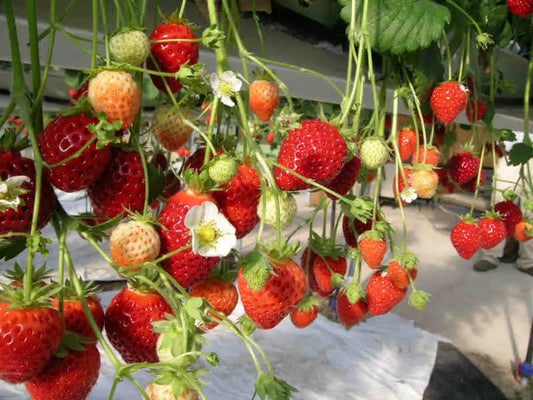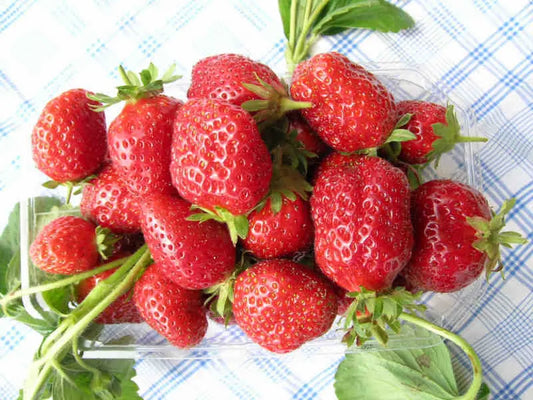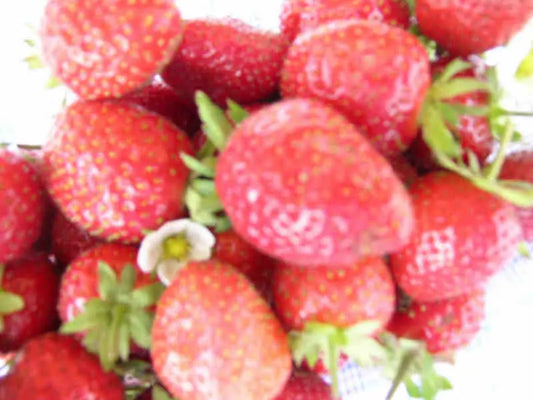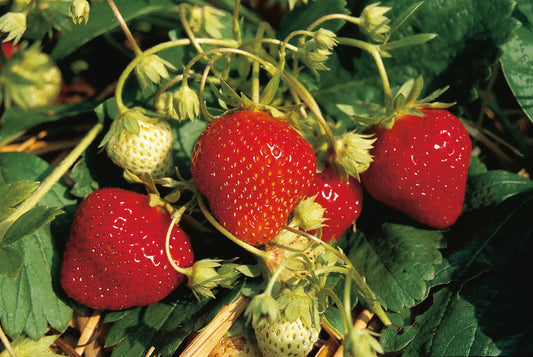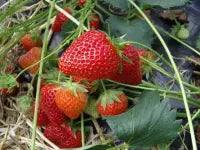Strawberry Runners for Professionals
Buy now and get it delivered when you're ready to plant
-
Gariguette Strawberry Runner
Regular price €0,16 EURRegular priceUnit price / per -
Ciflorette Strawberry Runner
Regular price €0,17 EURRegular priceUnit price / per -
Cigaline Strawberry Runner
Regular price €0,17 EURRegular priceUnit price / per -
Rubis des Jardins Strawberry Runner
Regular price €0,17 EURRegular priceUnit price / per -
Cirafine Strawberry Runner
Regular price €0,19 EURRegular priceUnit price / per -
Cijosée Strawberry Runner
Regular price €0,19 EURRegular priceUnit price / per -
Cirano Strawberry Runner
Regular price €0,19 EURRegular priceUnit price / per -
Mara des Bois Strawberry Runner
Regular price €0,20 EURRegular priceUnit price / per -
Charlotte Strawberry Runner
Regular price €0,20 EURRegular priceUnit price / per -
Cantaliss Strawberry Runner
Regular price €0,20 EURRegular priceUnit price / per
Collapsible content
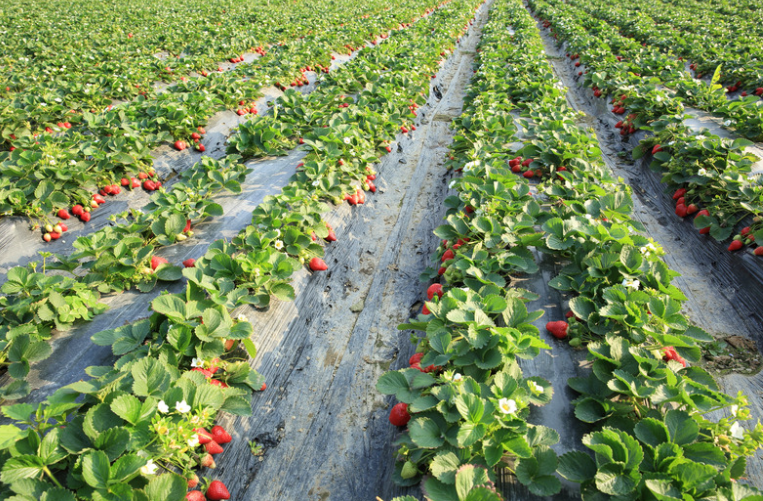
Strawberry Plant Buying Guide: What Type of Plants? For What Market Opportunity?
Which format should you choose: refrigerated, fresh, tray-plants, waiting bed, or plugs? Compare yields, costs, and harvest times at a glance.
Download the PDF guide (13 pages)
Why read this guide?
- Comparison tables: yield (300–600 g/plant), cost & labor.
- Reservation/delivery calendar for each format.
- Minimum order: 20 to 1,000 plants depending on the type.
- Full-field vs. above-ground case studies to maximize margin.
Overview of the 5 professional formats
Detailed comparison of formats
| Format | Yield (g/plant) |
Harvest time | Min. order | Average cost |
|---|---|---|---|---|
| Fridge | 250 – 400 | 120 days | 20 plants | 0.20 – 0.45 € |
| Costs | 280 – 420 | 140 days | 200 plants | 0.20 – 0.45 € |
| Tray plant | 400 – 600 | 90 days | 500 plants | 0.75 – 0.80 € |
| Waiting Bed | 300 – 500 | 105 days | 500 plants | 0.50 – 0.60 € |
| Motte | 230 – 350 | N+1 | 1,000 plants | 0.35 – 0.50 € |
Delivery schedule
| Plant type | Jan | Feb | Mar | Apr | May | Jul | Jul | Aug | Sep | Oct | Nov | Dec |
|---|---|---|---|---|---|---|---|---|---|---|---|---|
| Fridge | ||||||||||||
| Tray plants | ||||||||||||
| Waiting Bed | ||||||||||||
| Motte | ||||||||||||
| Costs |
Which format for which scenario?
Full field controlled budget
Fridge or Fresh : cost 2 x lower than tray plants, planting flexibility.
Above ground in greenhouse
Tray-plants : harvest 90 days after planting, uniform size, reduced labor.
Late planting
Mottes : planting July–August, rapid recovery, harvest the following year.
Ready to plan your plantings?
Download the complete guide Request a quoteFrequently Asked Questions
Is the guide free?
Yes, no fees or obligation to purchase.
How to download it?
Click the button “Download the guide” ; the PDF opens immediately.
Can I request a personalized quote?
Of course: write to us at contact@fraisiverse.com and an agronomist will respond to you within 24 hours.
Choosing the right strawberry varieties for your plot
Extend your harvest season by up to 5.5 months with our "early + season + everbearing" method. Compare 78 cultivars, sizes, and markets.
Download the PDF guide (17 pages)
4 axes to decide quickly
- Harvest Window : Early, Seasonal, or Everbearing? Combine them for 5.5 months .
- Commercial outlet : direct sales, long circuit, processing or freezing.
- Type of plants : fridge, fresh, root ball, tray plants… adapt your investments and your schedule.
- Growing conditions : open field, soilless, greenhouse; target consistent yield and size.
Axis 1: Select your harvest window
Example of recommended mix:
- Ciflorette (early) → Rubis des Jardins (season) → Charlotte (remontant).
- 5.5 months of continuous production, ideal for direct sales.
Axis 2: Sell at the right market
Direct sales
Ciflorette, Charlotte, Mara des Bois: premium taste sought after by consumers.
Long circuit / GMS
Magnum, Clery, Dream: uniform size, 95% class 1 fruit.
Transformation
Darselect, Mara des Bois – high sugar content and stable aroma.
Freezing
Honeoye, Belrubi – firm flesh, keeps well in the cold.
Axis 3: Choose the right type of plants
| Kind | Reservation | Delivery | Highlights |
|---|---|---|---|
| Fridge | All year round | Dec. → Aug. | Flexibility & price |
| Tray plants | Feb. → June | Nov. → Apr. | Above ground, harvest 90 days after planting |
| Motte | Sep. → May | Jul. → Sep. | Ideal for open fields, harvest N+1 |
| Costs | Feb. → Aug. | Sep. → Nov. | Young plants, rapid recovery |
Axis 4: Optimize your technical constraints
Tray plants guarantee +25% yield and simplified harvesting above ground; ideal for mechanizing your production and ensuring consistent size.
Frequently Asked Questions
Is the guide really free?
Yes, with no cost or obligation to purchase.
How to download it?
Just click the button “Download the guide” at the top of the page; the PDF opens immediately.
Can I request a personalized quote?
Of course: contact us via our contact page .
When to plant? When to harvest?
Do you want to start a strawberry farm but don't know when to reserve your plants, when to plant them or even harvest them?
Because we love 🍓 (with just a little sugar), we're going to do the work for you. On this page, you'll find the growing steps for each type of strawberry plant. When to order? What is the delivery period? When to plant? And finally, when to harvest?
Production Calendar - Frigo Strawberry Plants
| Production Calendar - Frigo Strawberry Plants | ||||||||||||||||||||||||
|---|---|---|---|---|---|---|---|---|---|---|---|---|---|---|---|---|---|---|---|---|---|---|---|---|
| Jan | Feb | Mar | Apr | May | Jun | Jul | Aug | Sep | Oct | Nov | Dec | |||||||||||||
| Reservation | ||||||||||||||||||||||||
| Deliverable | ||||||||||||||||||||||||
| Recommended planting | ||||||||||||||||||||||||
| Harvest | ||||||||||||||||||||||||
Production Calendar - Fresh Bare-Root Strawberry Plants
| Production Calendar - Bare Root Strawberry Plants | ||||||||||||||||||||||||
|---|---|---|---|---|---|---|---|---|---|---|---|---|---|---|---|---|---|---|---|---|---|---|---|---|
| Jan | Feb | Mar | Apr | May | Jun | Jul | Aug | Sep | Oct | Nov | Dec | |||||||||||||
| Reservation | ||||||||||||||||||||||||
| Deliverable | ||||||||||||||||||||||||
| Recommended planting | ||||||||||||||||||||||||
| Harvest | ||||||||||||||||||||||||
Production Calendar - Strawberry Plants Plugs
| Production Calendar - Strawberry Plants Motte | ||||||||||||||||||||||||
|---|---|---|---|---|---|---|---|---|---|---|---|---|---|---|---|---|---|---|---|---|---|---|---|---|
| Jan | Feb | Mar | Apr | May | Jun | Jul | Aug | Sep | Oct | Nov | Dec | |||||||||||||
| Reservation | ||||||||||||||||||||||||
| Deliverable | ||||||||||||||||||||||||
| Recommended planting | ||||||||||||||||||||||||
| Harvest | ||||||||||||||||||||||||
Production Calendar - Strawberry Plant Tray
| Production Calendar - Strawberry Plants Motte | ||||||||||||||||||||||||
|---|---|---|---|---|---|---|---|---|---|---|---|---|---|---|---|---|---|---|---|---|---|---|---|---|
| Jan | Feb | Mar | Apr | May | Jun | Jul | Aug | Sep | Oct | Nov | Dec | |||||||||||||
| Reservation | ||||||||||||||||||||||||
| Deliverable | ||||||||||||||||||||||||
| Recommended planting | ||||||||||||||||||||||||
| Harvest | ||||||||||||||||||||||||
Our Growing Guides by Plant Type / Our Growing Tips
Our online advisor: Fraisibot
Our technical itineraries by type of strawberry plant:
Technical Itinerary for Growing Strawberries from Frigo Plants
Technical Itinerary for Growing Strawberries from Plug/Pod Plants
Technical Instructions for Growing Strawberries from Tray or Mini Tray Plants
Technical Guide for Growing Strawberries from Bare-Root Fresh Strawberry Plants
Technical Instructions for Growing Strawberries from Waiting Bed Plants
All our growing tips for planting strawberries:
Strawberry Plants: Soil Preparation and Planting
Soil preparation for strawberry growing, planting techniques, and optimizing strawberry yield.
Best Practices for Irrigation and Fertilization of Strawberry Plants
Efficient irrigation systems, frequency and quantity of watering, types of fertilizers and application times, signs of nutritional deficiencies, growing strawberries in substrate, protection against frost and diseases.
Protection and Prevention of Strawberry Diseases and Pests
The main diseases and pests affecting strawberries, as well as effective methods for their prevention and treatment, including biological control and the use of resistant varieties. It provides practical advice for maintaining healthy and productive strawberry crops.
Succeeding in Strawberry Farming: Costs, Business Strategy and Subsidies
Growing strawberries requires significant initial and ongoing costs, but with effective marketing strategies and sustainable practices, growers can maximize their profits while contributing positively to the environment. Grants and financial aid are available to support necessary investments and encourage environmentally friendly farming practices.
Maximizing Strawberry Harvest and Storage: A Practical Guide
How to determine the optimal time to harvest strawberries, best practices for minimizing fruit damage during picking, and effective methods for storing and managing unsold strawberries to avoid losses and maximize profitability. It offers practical tips for extending the shelf life of strawberries, including refrigeration, freezing, and dehydration.
Strawberry Growing: Why Stagger Production? Early, Seasonal, Late? How to Choose?
Staggering strawberry production allows for harvests to be spread throughout the season, ensuring optimal fruit quality and increased profitability. Learn about recommended varieties for early, mid-season, and late-season production, as well as best practices for harvesting and storage.
-
Delivery from 10 plants to France, Switzerland and Europe
Delivery methodWe deliver anywhere in France as quickly as possible. Cost/quality balance is our priority.
-
Strawberry Plant Wholesale Supplier
About UsWe work with dozens of producers to offer you the best prices.
-
Quality Strawberry Plants
Strawberry Technical ItinerariesOur producers are selected for their reliability and the quality of their products.
-
Collection: Strawberry Runners for Professionals
Quick read / the essentials on our strawberry runners
At Fraisiverse , we are the leading wholesale supplier of strawberry runners for professional growers. Our expertise and know-how allow us to offer carefully selected batches of runners for the production of high-performance plants. For all growers looking to buy strawberry runners , our range offers flexible, reliable, and technically efficient solutions.
Coming from mother plants grown under strict sanitary conditions, our runners guarantee vigor, uniformity and rapid rooting. Their use allows us to produce various types of plants: fresh, refrigerated, in plugs or tray plants, depending on your growing system. As a specialist wholesale supplier of strawberry runners , we are committed to providing you with calibrated runners, ready to be rooted and integrated into your nursery with a high success rate.
Thanks to our efficient logistics network, you can buy strawberry runners with complete peace of mind, with fast delivery and packaging adapted to professional requirements. Fraisiverse , a specialist wholesale supplier of strawberry runners , provides you with personalized technical support to guarantee the success of your vegetative propagation.
Whether it's to gain autonomy, reduce planting costs or enhance your varietal selection, choosing to buy strawberry runners from our team is a strategic decision to secure your agronomic and economic objectives.
Introducing our Strawberry Stolon range
At Fraisiverse , we provide professional strawberry growers with a wide range of carefully selected strawberry runners for plant production. This vegetative propagation method is ideal for producers wishing to control their varietal renewal, reduce their planting costs or develop partial autonomy in their technical itinerary.
Our runners are grown from high-quality mother plants, cultivated under controlled conditions to ensure vigor, root potential, and uniformity. Each batch is prepared to ensure good growth in the nursery, whether for planting in pots, plugs, or directly in the ground, depending on the system chosen.
Available in different lengths and sizes depending on your needs, they can be adapted to various production schedules (spring plants, autumn plants, or short-cycle tray plants). Their cultivation allows for the production of healthy plants, adapted to the commercial and technical requirements of professional circuits.
Our commercial commitments for strawberry runners
As a strawberry specialist and dedicated supplier to professionals , Fraisiverse is committed to providing a simple, seamless and reliable supply . Our strawberry runners are delivered throughout France , with careful packaging allowing transport without damaging the plant material.
We offer personalized technical support to each client, with:
- Free quotes , tailored to your growing plan
- Dedicated technical support , able to provide you with a complete production itinerary
- A responsive sales service , with a response within 48 hours
The order can be reserved in advance of the season to secure your volumes, or placed during the active period with delivery within 15 days .
We apply producer prices , with decreasing pricing according to volumes , in order to guarantee unbeatable value for money at all surface levels.
With Fraisiverse , purchasing professional strawberry runners becomes a simple, secure and technically supported process.
Strawberry runner control: the pillar of professional vegetative propagation
Biological functioning of the stolon and production of clones
For a professional strawberry grower, mastery of their plant material is a major strategic lever. At the heart of strawberry reproduction methods is the stolon , a biological structure essential for the sustainability and adaptation of crops. The stolon is defined as an aerial stem , emitted by the mother plant, which develops horizontally above the ground. At regular intervals along this stem, nodes form which give rise to young plantlets , small leafy rosettes. These plantlets are thus transported a certain distance from the mother plant before gradually descending towards the ground. In contact with the soil, when the seedling reaches about four leaves, the node develops roots , allowing the rooting and autonomy of the new plant. This process constitutes a natural mode of vegetative reproduction which results in the production of clones . These clones are genetically identical to the mother plant, guaranteeing the faithful conservation of all its varietal characteristics , whether it be flavor , fruit size or even precocity .
Factors influencing stolonization under cultural conditions
Physiologically , the emission of runners, a phenomenon called stolonization , is strongly influenced by environmental conditions , including long days and high temperatures , typical of summer. When day length exceeds about twelve to thirteen hours and the temperature exceeds about 23°C, an axillary bud of the mother plant elongates to form the stolon that bears seedlings. This cycle of runner production generally occurs after the fruiting period and is completed in the autumn, when the plant prepares for floral induction and entry into winter dormancy .
Practical management of primary and secondary stolons
It is useful to distinguish between primary stolons , emitted directly by the mother plant, and secondary stolons , which develop from an already formed seedling. In production practice, it is commonly recommended to remove secondary stolons so as not to exhaust the vigor of the mother plant and to concentrate its energy on the development of primary seedlings. In addition, a single stolon can potentially carry several successive seedlings. However, to ensure the best vigor of young plants, it is often advisable to keep only the first well-developed seedlings and to cut the stolon beyond the first or second seedling, as more distant seedlings are generally less robust.
Technical choices between self-production and purchasing commercial plants
Agronomic advantages and limitations of self-produced plants
In professional strawberry growing, several types of plants, mainly from runners, are used, each with characteristics adapted to specific uses. Among these options, the production of plants directly from runners present on the farm ("self-produced" plants) offers significant advantages. The cost of establishment is considerably reduced, as there is no need to purchase external plants, which gives the producer greater autonomy . This also makes it possible to maintain the farm's own varietal selection and to plan planting dates according to specific needs.
However, this method requires a significant investment in time and labor for monitoring the mother plants , weeding and harvesting the stolons. A significant health risk is associated with self-production: diseases present on the mother plant can be transmitted to the stolons, which can lead to progressive degeneration of the plant if rigorous health management of the mother plants is not applied. In addition, self-produced stolons do not always achieve the calibration and uniformity offered by professional nurserymen.
Characteristics of the main types of plants from stolons
Fresh bare-root plants
Fresh bare-root plants are young rooted runners, pulled up in summer (July to September) and planted immediately without substrate. They are economical and available in the middle of the planting season (late summer/autumn) for short-day, non-remontant varieties . They recover quickly if planted quickly (ideally within 48 hours), but they are fragile to handle and require immediate post-planting sprinkler watering . Their storage is limited to the very short term in cold storage.
Bare-root refrigerator plants
Frigo plants are bare-root plants pulled up in late autumn or winter, stored in a cold room at -2°C before being planted later. They allow the planting schedule to be shifted over several months and the harvests to be spread out, used for spring or summer production depending on the variety. High-calibre frigo plants (A or A+) offer high production potential. Their limitations include the need for refrigeration infrastructure and a higher unit cost than fresh plants. A frigo plant takes approximately 30 days to flower and 30 to 40 days to fruit after planting.
Plants in a ball (pot)
Clod plants are runners taken and transplanted into small pots with substrate where they take root before delivery. A distinction is made between fresh clods (short growing, immediate planting) and cold clods (growing then cold storage). Their advantages lie in an almost certain recovery thanks to an active root system and a better tolerance to post-transplant water stress , allowing later planting . Their cost is however higher than bare-root plants , requiring equipment and often a greenhouse.
Tray plants and mini-tray plants
Tray plants are large-sized plants produced in honeycomb trays with a voluminous, strongly rooted substrate. Often grown from several crowns , they offer very rapid fruiting and maximum yield potential from the first year, being used for forced or off-season production . They allow strawberry harvests to be planned outside of spring . However, they are very expensive (up to €0.5-0.7 per unit) and their cultivation is long and requires extensive fertilization . Important note : the use of certified organic tray plants has been prohibited in organic farming since 2022 .
Mini-tray plants are similar but with about half the root ball size , offering a slightly lower unit cost while retaining high initial yield potential and planting flexibility . Like tray plants, they are not permitted in organic farming .
Plants "waiting bed" (WB)
Finally, "waiting bed" (WB) plants are stolons or young plants pre-raised in the ground at the end of summer, which develop there and produce flowers before being pulled up in winter as large dormant plants for early planting. This technique, more economical than tray plants , is mainly reserved for nurserymen .
Self-production: agronomic and economic benefits
Clonal reproduction and varietal maintenance
Using one's own stolons as plant propagation material represents a definite agronomic and economic interest for the professional producer, even if it involves challenges.
From an agronomic perspective, propagation by runners allows for the identical reproduction of the cultivated variety, without genetic variation. Unlike sowing, this guarantees the maintenance of the specific qualities of the variety (shape, taste, earliness) as long as the mother plant is healthy. This approach ensures varietal autonomy and the genetic sustainability of cultivars on the farm, making it possible to preserve favorite or old varieties that are not commercially available.
The major pitfall lies in the risk of transmission of pathogens present in or on the mother plant to the runners. The successive accumulation of viral and fungal loads can cause progressive degeneration of the plants, reducing their vigor, their yield and increasing their sensitivity to stress. This situation, historically observed before the adoption of rigorous sanitary techniques in nurseries, requires constant sanitary vigilance during self-production. When well managed, self-production offers independence from nurserymen and allows for mass selection at the farm scale, for example by choosing the best-performing plants as mother plants.
Savings on implementation costs
Economically, the cost of purchasing plants is a major expense in strawberry growing, ranging from approximately €0.15 to €0.70 per commercial plant, or an initial investment of €6,000 to €25,000 per hectare for a typical density of 40,000 plants/ha. By producing their own plants via runners, the producer can make substantial savings on these establishment costs. Direct expenses are limited to the maintenance of the mother plant plot (irrigation, fertilization) and the labor required for the care and harvesting of runners. For a small or medium-sized farm, this reduction in initial costs can significantly improve profitability . However, it is essential to include the indirect cost of labor devoted to this activity, which represents time spent to the detriment of other potentially productive tasks. In professional nurseries, labor accounts for more than 45% of production costs, mainly due to weeding and manual handling. This labor, although related to a smaller area, therefore remains significant on the farm.
Health risks and regulatory obligations
Plant autonomy also involves compliance with regulatory and health aspects . Professional nurserymen benefit from certification schemes guaranteeing varietal identity and plant health (healthy initial material, phytosanitary controls). By multiplying their runners, the producer assumes the responsibility of ensuring the health of their mother plants and monitoring diseases, not having these external controls. Another crucial point is compliance with legislation on breeders' rights : most modern varieties are protected , only authorizing on-farm multiplication under certain conditions. Typically, the strawberry grower must declare the areas multiplied and pay royalties to the breeder, except for varieties in the public domain or free of rights .
In summary, the use of "homemade" runners is of agronomic interest for preserving varieties and of economic interest for reducing the plant budget, provided that the health aspect is controlled. This provides significant strategic flexibility , particularly in organic farming where the certified supply is sometimes limited (exemptions exist for the use of conventional runners if organic ones are unavailable).
Optimal conditions for a successful runner nursery
Agronomic criteria for choosing the plot
The success of runner production depends largely on the conditions in which the mother plants are raised . The choice of plot is essential. It is important to select healthy, fertile and well-drained soil. Light soils , with a sandy or sandy-loam texture, are particularly suitable because they encourage the rooting of seedlings and facilitate the uprooting of young plants by allowing the soil to easily detach from the roots. The optimal pH is in a slightly acidic to neutral zone, around 6.5-7.5. It is crucial to avoid excess water ; in the case of a perched water table or a tendency to hydromorphism, subsoiling or cultivation on mounds can improve drainage. Conversely, excessively stony or compacted soils should be avoided so as not to hinder the rooting and harvesting of runners.
Crop rotation and management of pathogenic backgrounds
A broad crop rotation is essential before planting the mother plants. It is recommended not to replant strawberries on a plot for at least 5 to 6 years , or even more than 8 years if possible. If there is a history of serious soil-borne disease such as Phytophthora (red root rot), a rotation of 15 to 20 years or a change of land is necessary. Good previous crops include cereals or temporary meadows that clean the soil. It is imperative to avoid previous crops of the Solanaceae family (potatoes), which can introduce risks of Verticillium and Rhizoctonia , as well as other hosts of common pathogens or potential sources of viruses . In short, the nursery plot must be far from sources of contamination . Installing the nursery behind a green manure or a well-managed young meadow is a common practice that ensures clean, humus- rich soil with little weed cover. An addition of mature compost (30 to 50 t/ha) before planting the mother plants can provide sufficient basic nutrition for 2 to 3 years.
Influence of local climate and planting strategy
Climate and microclimate also influence runner production. Strawberry, a temperate climate plant, is frost-resistant in dormancy (-20°C at the root collar), but is sensitive to high temperatures . Vegetative growth is optimal between 10°C and 25°C . Above 30°C, the plant experiences stress that can slow runner production and require increased irrigation or protection against heat waves . Below 5°C, vegetation is dormant. The most favorable period for active runner production is spring and summer . Regional differences exist: in northern climates or at high altitudes, the summer is shorter, requiring the mother plants to be planted earlier in spring. In southern areas, very hot summers can stop runner formation in July-August, requiring production to be concentrated in late May-early July and possible resumption in September. Techniques such as partial shading or cooling watering can be helpful. It is essential to plan runner production according to the local climate.
Impact of varietal choice on stolonisation potential
Varietal choice has a direct impact on runner capacity . Some varieties are very stoloniferous (e.g., classic non-remontant varieties), while remontant varieties naturally produce fewer runners. The latter also require more nutrients to support both fruiting and vegetation . To propagate a poorly stoloniferous variety, it is necessary to provide more mother plants or accept a lower production per plant. Regardless of the variety, removing the flower stalks from the mother plants as soon as they appear is recommended to redirect the plant's energy towards the formation of runners and seedlings.
Water and Nitrogen Nutrition Management
Irrigation is essential for runner production. Strawberry plants in vegetative growth consume significant amounts of water (up to 3 to 5 mm/day in summer). The soil must be kept constantly cool during the runnering period (June to September) to ensure rapid rooting of the seedlings . Sprinkler irrigation is often preferred initially because it moistens the soil surface and the seedlings, promoting root emission at the nodes, and it cools the atmosphere. Once the seedlings are rooted, drip irrigation can take over, although pipes can be hampering. Without available water, the runners will dry out before rooting .
Soil fertility is also crucial. Strawberry plants, in the vegetative propagation phase, need sufficient nitrogen nutrition . Ensuring a good organic matter content (pre-incorporated compost) is important. Mineral nitrogen inputs may be necessary during cultivation if the leaves turn pale, a sign of deficiency. An initial excess of nitrogen could excessively stimulate the foliage to the detriment of the runners; a fine balance must be found, potentially guided by soil analyses . Aiming for bright green foliage indicates good nutrition, but avoid excess, which weakens the tissues and promotes disease.
Planting density and nursery management
Finally, the conditions under which the mother plants are planted influence production. Sufficient spacing between rows (60-80 cm) and on the row (30-40 cm) allows the stolons to spread out . A configuration of wide beds with isolated mother plants facilitates radial rooting . The main thing is to leave space for the seedlings and interventions (weeding, harvesting). The mother plants are preferably planted in spring (March-April) for summer production, or at the end of summer of year N for production from spring N+1 .
Cultivation techniques to maximize runner quality
Selection and sanitary preparation of mother plants
Running a strawberry nursery dedicated to the production of quality runners involves several key steps. The first is the choice and preparation of the mother plants , which determines the genetic and health quality of the future plants. The ideal is to start with certified and healthy mother plants , if possible from in vitro meristem culture , guaranteeing the absence of the main viral and fungal diseases at the start. Although more expensive (pre-basic or Elite certified plants), this initial investment is largely offset by the quality of the thousands of runners produced . Some producers use selected vigorous plants in their production, but this option is riskier (latent viruses). It is advisable to renew the mother plants periodically , for example a third each year, and not to keep them beyond 2-3 years to avoid exhaustion and the accumulation of pathogens . The varietal choice should favor well -adapted and stoloniferous varieties. Preparation of mother plants before planting includes checking and possibly pruning the roots , acclimatization and pralinating the roots in clay mud to encourage recovery. Planting is done at the flush collar , followed by copious watering . Careful monitoring is necessary during the first few weeks.
Physiological stimulation of stolon emission
Stimulating runner development is a priority once the mother plants are established. The key technique is to remove flowers and flower stalks as soon as they appear, to redirect energy toward vegetative growth and runner production rather than fruit. On non-everbearing varieties, the first flowers appear in late May/June; on everbearing varieties, remove flowers during the target runner formation period. A fruiting strawberry plant produces significantly fewer runners. Sufficient nitrogen fertilization is also necessary, often in June-July, via split fertilizers or fertigation . Monitoring leaf color (bright green vs. pale/yellow) indicates nutritional status . Other elements such as potassium, calcium , and boron contribute to tissue strength and root development . Regular weeding is crucial because competition weakens runner production. Maintaining adequate soil moisture is also fundamental. Managing the number of runners per mother plant improves quality. The first (primary) runners produce the best plants; limiting the number (e.g., 3 to 5 per mother plant) by removing the following ones helps concentrate vigor. Pinching the tip of a runner after two well-formed seedlings prevents the formation of a third one unnecessarily.
Positioning and rooting of seedlings
For seedlings to root well , keeping the soil moist encourages adventitious root formation at the node. Manually positioning seedlings on the soil if they remain hanging, or even pinning them down with staples or metal clips, promotes soil-seedling contact . Sprinkling potting soil around them or placing seedlings directly in small pots filled with substrate under the runner are excellent techniques, facilitating rooting in the root ball and subsequent transplanting . Using shallow trays or crates under dense areas also allows several seedlings to root simultaneously . Thinning out dense foliage around seedlings ensures they receive sufficient light. Anything that promotes light, moisture, and soil-seedling contact is beneficial.
Optimal timing and methods of weaning
Separation and rooting of young plants , or weaning , is the detachment of seedlings from the mother plant. The ideal time is when the seedling has a small visible root hair and at least 3-4 well-developed leaves (about 5 cm in diameter), often 10 to 20 days after emergence in summer. Waiting about 2 weeks after rooting allows the seedling to accumulate reserves . Weaning too early can compromise recovery . Waiting too late can weaken the connection with the mother. The weaning period often runs from mid-August to the end of September for plants transplanted immediately. Use disinfected pruning shears or a knife to cut the stolon 1-2 cm from the base of the seedling, ideally on an overcast day . After cutting, the young plant must be transplanted immediately , either in a temporary nursery , in a pot, or in its final location. If transplanted into the ground, dig a hole, insert the roots, tamp down and water. If already rooted in a pot, simply cut the stolon and remove the pot, keeping it in moist shade . Post-weaning care is crucial: water immediately after separation to avoid water stress . Plants transplanted into pots should be placed in partial shade for a few days. In the ground, temporary shading or frequent, light watering (3-5 L/m² per day for the first week) helps recovery. Monitoring and quickly replacing plants that do not recover is important. It is also essential to mark batches by variety and date of collection to ensure traceability .
Cultural hygiene and health management
Health monitoring and weeding are constant points of vigilance. Any health problem in mother plants can be transmitted. Regularly inspect mother plants to detect symptoms of viruses (variegated/deformed leaves, dwarfism). Immediately pull up and destroy plants suspected of having viruses and their runners. Monitor and treat, if necessary , fungal diseases (spots, powdery mildew). Control pests (aphids, leafhoppers, mites), which are potential vectors of viruses or weaken plants. Preventive methods (anti-insect nets, auxiliaries) or curative methods (targeted treatments) should be considered. Inspect the roots in case of dieback (Phytophthora, white grubs) and act accordingly. Cultural hygiene is essential: wash your hands, disinfect tools (pruning shears, knives) between each potentially diseased plant to avoid the mechanical transmission of viruses and fungi. Avoid spreading soil fungi by cleaning boots.
Weeding and winter protection of the nursery
Weeding is a major challenge in stolon nurseries. Mechanical methods are limited once the stolons spread. After any pre-planting treatments , all weeding becomes manual . Regular weeding or hoeing is essential to avoid competition and shading on the seedlings. Plastic mulch around the stock plants can limit weeds, but may require manual assistance for stolons to root . The cleanliness of the nursery is essential for the quality of the stolons. Allowing the time necessary for rigorous manual weeding is essential. Finally, if the stock plants remain in place for a second year, winter protection (straw mulch) can be applied to protect the crowns from frost , especially in cold regions. Strawberry stock plants are hardy, but young late seedlings can suffer. Mulching also helps against winter weeds. Gradually remove the mulch in spring. Maintaining this health and weed control vigilance requires constant effort but results in healthier and more vigorous plants .
To summarize: Our strawberry runners
As a specialist wholesale supplier of strawberry runners , Fraisiverse supports you in every step of your propagation strategy. Our runners are selected for their rooting capacity, genetic vigor, and compatibility with different growing systems. Thanks to our offer, buying strawberry runners becomes a simple, economical, and technically controlled process.
Our professional customers benefit from tailor-made technical support, responsive order tracking and fast delivery throughout France. Whether for a one-off need or a structured propagation plan, Fraisiverse , a specialist wholesale supplier of strawberry runners , guarantees you available volumes and suitable packaging. Each batch is carefully prepared to optimize recovery in pots, clods or open ground.
By choosing to buy strawberry runners + all varieties from us, you benefit from excellent value for money, secure stock and reliable agronomic support. Whether you are self-producing or looking for high-performance plants, buying strawberry runners from Fraisiverse , a specialist wholesale supplier of strawberry runners , means opting for performance, responsiveness and field expertise.
In short, our strawberry runners are a key solution for optimizing your technical processes, gaining independence, and ensuring the longevity of your favorite varieties. Trust Fraisiverse to professionalize your plant propagation with high-quality runners.
Fraisiverse - Your supplier of quality strawberry plants. Organic or conventional. Delivery throughout France. Wide range of strawberry plants: Tray Strawberry Plants, Motte Strawberry Plants, Frigo Strawberry Plants, Waiting Bed Strawberry Plants. Strawberry plants for professional and private strawberry growers





